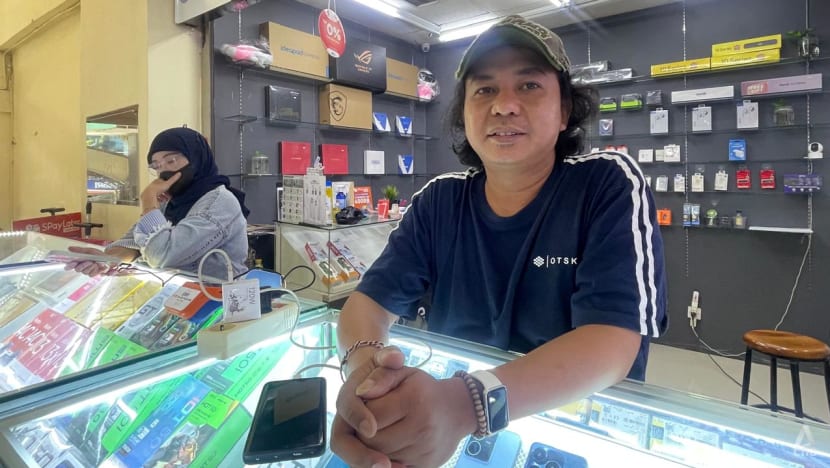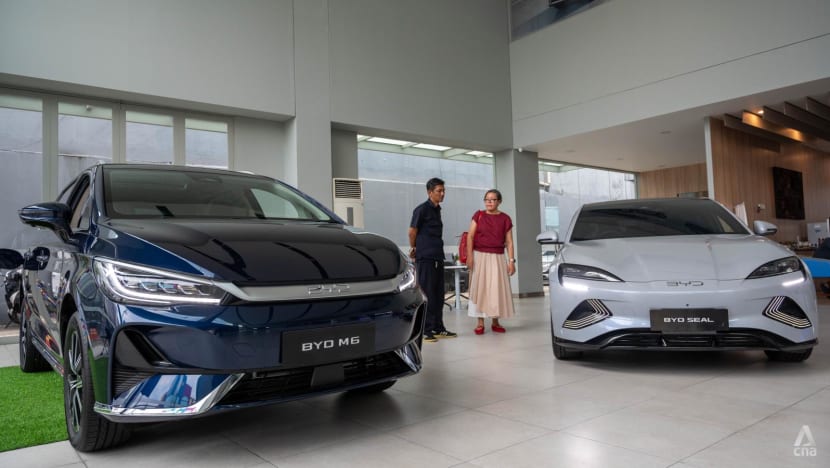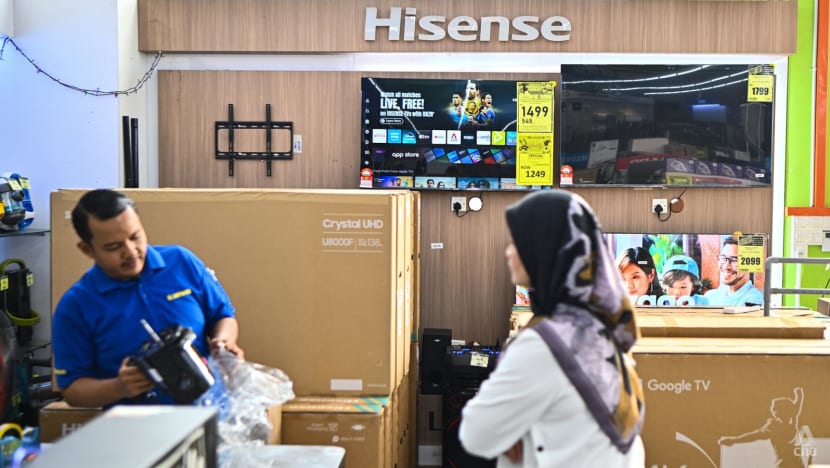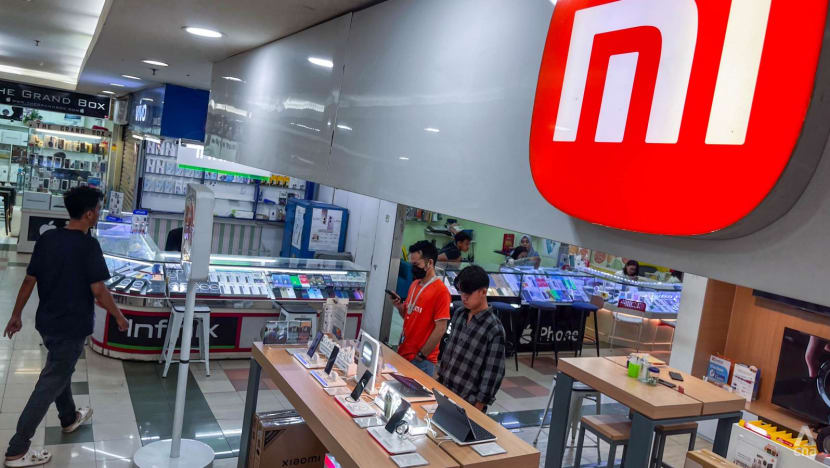Chinese consumer brands gaining foothold in Indonesia, Malaysia as they shed ‘world’s factory’ image
Even as the popularity of Chinese products surge in Southeast Asia, experts say that they continue to face challenges in being recognised as top brands in certain fields.

A Mixue outlet in South Jakarta, Indonesia. Mixue outlets are ubiquitous in Southeast Asia's largest economy. (Photo: CNA/Ridhwan Siregar)

This audio is generated by an AI tool.
JAKARTA/KUALA LUMPUR: When Indonesian Dwi Soejatmoko, 42, bought his first television set about 20 years ago, he opted for a brand he had never heard of before: Changhong.
Since he was just fresh out of university then, Dwi was price-conscious and the Chinese brand was affordable.
At that time, Chinese brands were often considered of lower quality, but Dwi did not dwell much on it as long as he could watch his favourite programmes on TV.
But to his surprise, the household appliance functioned well. It even still works today, two decades later.
Now, Dwi owns not just a China-branded TV, but also many other gadgets and appliances.
“Firstly, the prices are clearly competitive and low compared to brands from other countries,” Dwi told CNA.
“China used to be known as a country that copied products, but now it is a country that creates new product innovations in terms of technology and usability.”
For decades, Chinese-made products were synonymous with being mass-produced with little to no brand recognition.
The public also considers them to be inferior in quality to those that were made in Japan or in European countries. But that perception has slowly changed, and Chinese brands have become popular among consumers in Southeast Asia.
From smartphone brands such as Xiaomi, Vivo, and Oppo to automotive brands such as BYD and Chery to beverage outlets such as Mixue and Chagee, Chinese brands are now household names.
Experts whom CNA spoke to say that Chinese products are more well-received by the public as compared to before, and will continue to thrive in emerging markets like Indonesia and Malaysia.
“I think this is due to changing perceptions of China,” Lee Pei May of the Department of Political Science at the International Islamic University of Malaysia told CNA.
“It is now not regarded as the world's factory but as a technology powerhouse. So, consumers have more confidence in Chinese brands.”
But experts also caution that Chinese brands may still face some challenges in being truly recognised as top brands even as they believe that the nimbleness of these firms to respond to changing consumer appetites augurs well for their future in a competitive regional market.
POSITIVE CONSUMER EXPERIENCE
Today, Dwi owns a Lenovo laptop, handphones from brands such as Xiaomi, Huawei, Infinix, and Redmi as well as a Wuling electric vehicle. The list goes on.
According to him, Chinese products are affordable, widely available, and high-tech.

Dwi - who is an entrepreneur in the IT industry - believes that there are several reasons why Chinese products have found their place in Indonesian society.
"The effects of increased advertising and marketing, and easier-to-find product information. Their product innovation is also faster (than non-Chinese brands),” said Dwi, adding that he has not noticed significant differences between Chinese brands and non-Chinese ones - especially for consumer goods.
He added: “So perhaps there’s some prestige because certain brands like Samsung are more well-known. But there’s not much difference (in functionality).”
Iwan Kurniawan, 49, on the other hand, just purchased his first Chinese handphone from Xiaomi at the end of June for his primary school-aged son.
His 34-year-old nephew Indra Kusuma - who has been using a Chinese brand since 2014 - convinced him to buy the handphone, arguing that it is value for money.
“He (Indra) said the battery is long-lasting. And the phone doesn’t heat up easily,” said Iwan, adding that the Xiaomi phone was bought for 1.5 million rupiah (US$92).
It was a simple model, Iwan said, and enough as a starter phone for his young son.

Beyond electronics from Chinese brands, food and beverages from China have also flooded the Indonesian and other Southeast Asian markets in recent years.
According to Singapore research firm Momentum Works, as of the end of 2024, more than 6,100 outlets had been opened in Southeast Asia by over 60 Chinese brands in the three years preceding the end of 2024.
Meanwhile, Malaysia and Singapore are home to the most significant concentration of Chinese food and beverage brands. For instance, Malaysia is milk tea brand Chagee’s largest market outside of China, according to local media reports.
It is operating more than 150 stores there currently and aims to open another 300 within three years. Among other things, it sells milk tea, fruit tea, brewed tea and tea latte at prices starting from just above RM10 (US$2.40).
Malaysian student Arina Shafiqah told CNA that she frequents Chagee because of the variety of drinks available as well as the ambience of the outlets.
“The drinks are not exactly the cheapest in the market, but the taste and quality is good,” she said at one of Chagee’s outlets in Kuala Lumpur.
Arina added that she used to frequent McDonald's for its ice-cream and Starbucks for its coffee, but has boycotted both in her attempt to show solidarity with the Palestinian cause.
Over the past two years, calls for boycotts against companies with alleged links to Israel have been strong on social media platforms such as X, TikTok, Instagram and Facebook.
“I have no issue with Chinese outlets or brands. It’s nothing to do with the country but rather the quality of goods,” she said.

This sentiment is echoed by Malaysian strategic communications director Aditya Adri Saleh, 49, who also has no reservations about Chinese brands, having purchased an Xpeng G6 electric vehicle about 10 months ago after a test drive on its launch day.
He had considered a Korean brand at first, but its higher pricing was a deterrent.
After clocking more than 20,000km in mileage, he said there have been no major issues with the Xpeng G6, giving his nod of approval for the Chinese brand.
“Driving around, we still get stares from kids and adults alike not knowing what car it is, and being surprised when we tell them the name and where it was built,” Aditya told CNA.
He has also used Huawei and Honor smartphones, HiSense and Haier televisions, as well as a Xiaomi vacuum cleaner among other things.
“While others see it as an influx of inferior products that wouldn’t last long, I can attest from personal experience that I would not second-guess Chinese products until I test them out myself,” he said.

CHINESE BRANDS ON THE RISE
Mobile phone seller Rezky Alfonso, who hails from Tangerang on the outskirts of Jakarta, noticed that Chinese handphones have dominated the Indonesian market since around 2015.
The 36-year-old attributed it to the rise of the Android operating system, and the resulting affordability of Android phones has contributed to the dominance of Chinese brands in Indonesia.
Before that, he said the primary operating systems used by phones sold in Indonesia were the BlackBerry operating system and Nokia’s.
Rezky still sells Nokia phones and has people buying them, although not in large numbers.
Most of his customers are young people like gamers. They are price-conscious and know what they want, as information about various phone models is readily available online.
“People are increasingly buying Chinese brands' phones because they tend to offer higher specifications,” said Rezky.
“They're also more affordable and cheaper. The difference is quite significant.”
He said a Chinese phone can be sold for just about 1.5 million rupiah, but claims its specifications can be twice as good as those of Android phones from other companies, which are sold at twice the price.
The two brands that are sold the most at his shop in South Jakarta are Infinix and Xiaomi. And while there are some customers who prefer non-Chinese brands such as those from Korean conglomerate Samsung, the numbers are not significant.
They are mostly businesspeople who value their image and prestige, said Rezky.
According to global technology market firm Canalys, the top three mobile phone brands with the biggest market share in Indonesia in the first quarter of 2025 are all from China: Xiaomi with 19.5 per cent, Transsion with 17.4 per cent and Oppo with 16.5 per cent.
Samsung comes in fourth place with 16 per cent, followed by Vivo with 15.7 per cent.
Meanwhile in Malaysia, Canalys reported that Xiaomi led the country’s smartphone shipments with almost 16 per cent of market share in 2024, followed by Samsung, which held over 14 per cent.
This was followed by other Chinese brands Vivo (13.1 per cent), Oppo (12.5 per cent), Transsion (11.9 per cent), Realme (9.97 per cent), Honor (9.71 per cent) as well as US brand Apple at 8.36 per cent.
Globally, however, Samsung leads with a 19 per cent market share in the second quarter of 2025, followed by Apple with 16 per cent and Xiaomi with 15 per cent. Vivo and Transsion both hold a 9 per cent market share.

Beyond consumer goods, Chinese brands in the automotive industry are also rising in popularity in Indonesia and Malaysia, albeit at a slower pace.
Jongkie Sugiarto - co-chairman of the Indonesian Automotive Association (Gaikindo) - said that for many years, Japanese cars have held approximately 98 per cent of the market share in Southeast Asia’s largest economy.
Nowadays, Japanese cars make up less than 90 per cent of the market, as 15 Chinese brands have entered the Indonesian market and are eating into the Japanese share, he said.
Between January and June 2025, Gaikindo reported that the total number of whole vehicle sales in Indonesia was 374,740 units. And while the top five brands are still dominated by Japanese ones, China’s BYD came in at number six.
This is in stark contrast to the situation in 2016, when Japanese brands held 99 per cent of the market share, and Chinese ones had close to zero per cent market share, having sold only 85 units then.
Jongkie said an affordable price is one of the main reasons why Chinese cars are increasingly sought after in Indonesia.
“Our per capita income is around US$5,000. Therefore, our purchasing power is concentrated in cars priced at around 300 million rupiah or less,” said Jongkie.
“So, price is a crucial factor. And Chinese brands are priced in the range of 300, 400 and 500 million rupiah, so they’re certainly gaining market share.”
Chinese cars also suit Indonesians as they come in different models such as sport utility vehicles and multi-purpose vehicles, said Jongkie, adding that these brands enter the local market with a strategy, ensuring that spare parts are widely available and that after-sales services are readily accessible.

In Malaysia, Chinese brands made a notable impact in its automotive market last year, with Chery emerging as the fifth most popular and BYD securing the tenth spot in terms of sales, according to government data.
None of these brands were in the top 10 spots in 2023.
Shahrol Halmi, president and co-founder of the Malaysian Electric Vehicle Owners Club, believes that the rise of Chinese brands has directly coincided with the expansion of electric vehicles in the country.
"Their products, especially in electric vehicles, are very advanced and display China's peak in car manufacturing capabilities. They are world leaders in battery technology besides a whole suite of technologies that go into their cars,” he said, adding that without the influx of Chinese brands, electric vehicles accessibility in Malaysia would be challenging.
Citing cost as another factor, Shahrol pointed out that European brands sold their cars for at least RM200,000.
“Chinese brands are selling their cars for just above RM100,000, with consumers having more choices. What we have seen over the past one and a half years or so is how much value and technology is packed in cars compared to those that cost twice as much,” he said.
Habib Dzakwan, a researcher focusing on China at the Centre for Strategic and International Studies (CSIS) think tank in Jakarta said there are various reasons as to why there is an increase in Chinese products and brands in the regional market.
“From China's perspective, it's driven by the growth of China's manufacturing capacity for mass production, supported by an ecosystem that allows exports to developing countries.
“From Indonesia's perspective (for instance), consumers - the majority of whom are likely quite price-sensitive - find Chinese brands more attractive, supported by extensive promotional efforts,” he said.
Trade and investment expert Andry Satrio Nugroho from the Institute for Development of Economics and Finance (INDEF) said that Chinese brands are competitive because they have taken research and development seriously, resulting in high-quality products.
He added that the Chinese government also provides incentives to Chinese businesses, which enable mass-produced products to be sold at a low price.
Lee of the International Islamic University of Malaysia believed that the expansion of Chinese firms could also be driven by political reasons, pointing to the Chinese government’s “Zouchuqu” or “going out strategy” in 2000 that encouraged its enterprises to invest overseas.
“The expansion of Chinese firms to other markets is encouraged by their government and supported by certain government policies,” she said.
The Han Culture Centre of Malaysia president Goh Hin San, meanwhile, told CNA that Chinese companies do things “very quickly” and spend a lot on marketing and advertisements.
“When there is a new handphone for example, they spend a lot of money on advertising on television, the radio, newspapers, and billboards. In just three months, a new brand can become well-known,” said Goh, who organises expos for Chinese products.

CHALLENGES CHINESE BRANDS FACE
However, experts told CNA that Chinese brands still face challenges in emerging markets such as Indonesia and Malaysia.
Andry from INDEF said that the low-price-point strategy is not sustainable in the long run, as evidenced by today's trend of Chinese goods being manufactured in Vietnam to keep costs low.
Some Chinese brands also continue to face the perception that they are of lower quality compared to European ones, he added.
“I think that perception still exists. For example, there are still people who prefer European cars because they believe European vehicles are long-lasting and of higher quality.”
Jongkie from Gaikindo also thinks that Chinese brands will not overtake the dominance of Japanese ones soon, as Japanese ones have proven to be reliable and solid, which is something Chinese brands “need to work on”.
“Besides, Japanese brands would also evolve with new technologies and models to continue to win the race,” he said.
Habib from CSIS added that another challenge may lie in maintaining a balance between being present in Indonesia while not undermining domestic brands.
“Maintaining a presence in Indonesia means not focusing solely on sales. In several sectors, Indonesia also has its local brands that compete with Chinese brands, such as cosmetics, textiles, and even electric vehicles, to name a few,” he said.
“If not addressed, it's easy to trigger anti-Chinese sentiment. The crucial responsibility lies in synergising these products with domestic input components, local Indonesian brands, and Indonesian labour.”

Meanwhile, Lee noted that some Malaysian businesses have raised concerns about Chinese firms operating in the country driving down their profits.
“This is due to the fact that Chinese firms are highly competitive,” she said.
Separately, a player in the food and beverage industry in Malaysia told CNA on condition of anonymity that it is facing pressure from Chinese outlets that have sprouted up quickly.
While he has no issue with competition, he questioned how Mixue, for example, was able to offer their products at very low prices, citing the RM2 price for an ice-cream and RM5 for bubble tea.
“It’s a long-term battle and we just have to fight it out. It will remain to be seen how long they will be here,” he said.
“I do hope locals will support local brands and restaurants.”
But experts say that Chinese brands will continue to make inroads in the region, and will be difficult to ignore. Moreover, consumers who are rational, not “brand-minded” and those who prioritise functionality may continue to or further embrace these Chinese brands.
“They will continue to expand. As long as no one can match China's manufacturing capacity and technological innovation, the trend is unlikely to stop abruptly,” said Habib.
“The same holds for Indonesia. As long as Indonesians' purchasing power remains unchanged, consuming Chinese brands is a pragmatic yet rational choice.”













.jpg?itok=mO9f_7i3)








